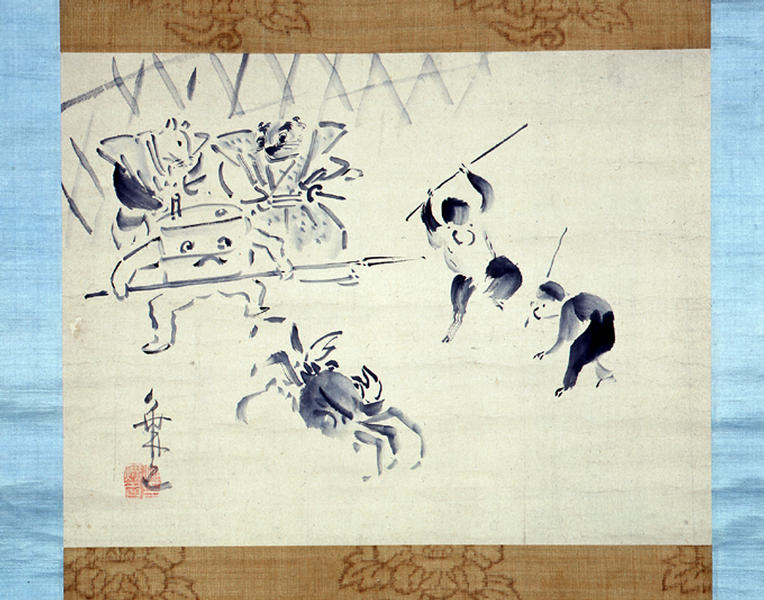猿蟹合戦図 池大雅筆
- 江戸時代
- 18世紀
- 紙本墨画
- H-42 W-54
解説(春の玉手箱)
池大雅が「猿蟹合戦」をアレンジした作品である。「猿蟹合戦」は、江戸時代からの五大昔話のひとつで、親蟹を猿に殺された子蟹の仇討ちが主題となっていて、現在でも広く親しまれており、少しづつ内容が異なる類話も多い。
本図は、二匹の猿と戦う子蟹を、槍を手にした臼が応援し、その背後に羽織袴姿の狐と狸が立ち会いをしているという極めてユニークな場面である。背景には竹垣があり、仇討ちが公認または称賛されていた江戸時代ならではの設定で興味深い。気迫いっぱいの子蟹に棒状のものを振り上げ打ちかかろうする猿を臼が槍で威嚇しており、もう一匹の猿は完全に腰が引けている。狐も狸も勝負の瞬間を見極めようと真剣である。簡略に描かれつつ各々の精神状態を窺うことができるのも、文人画を極めた大雅ならではの技量である。
Catalogue Entry
This is Ike no Taiga's rendition of the famous battle between a crab and monkeys. This tale was one of the "five great traditional tales" of the Edo period, and it takes as its theme the battle that occurred when a baby crab seek vengeance on the monkeys for having killed his parents. This tale is still widely known in Japan today and there are many related tales, each with a slight variant of the original theme.
This painting shows two monkeys battling the baby crab, and a mortar wielding a spear. In the background a fox and a badger wearing formal kimono stand as referees in this unique scene. The background is cut off by a bamboo fence, suggesting the fascinating concept that revenge was a formally recognized event in the Edo period. The mortar brandishes a spear to threaten one monkey who wields a spear‐like pole toward the wrought‐up carb, while the other monkey has been completely vanquished. This is the deciding moment in the battle, and fox and badger watch with intense focus. Taiga's immense skill as a literati style painter can be sensed in his superb depiction of each animal's psychological state in only a few abbreviated brushstrokes.
